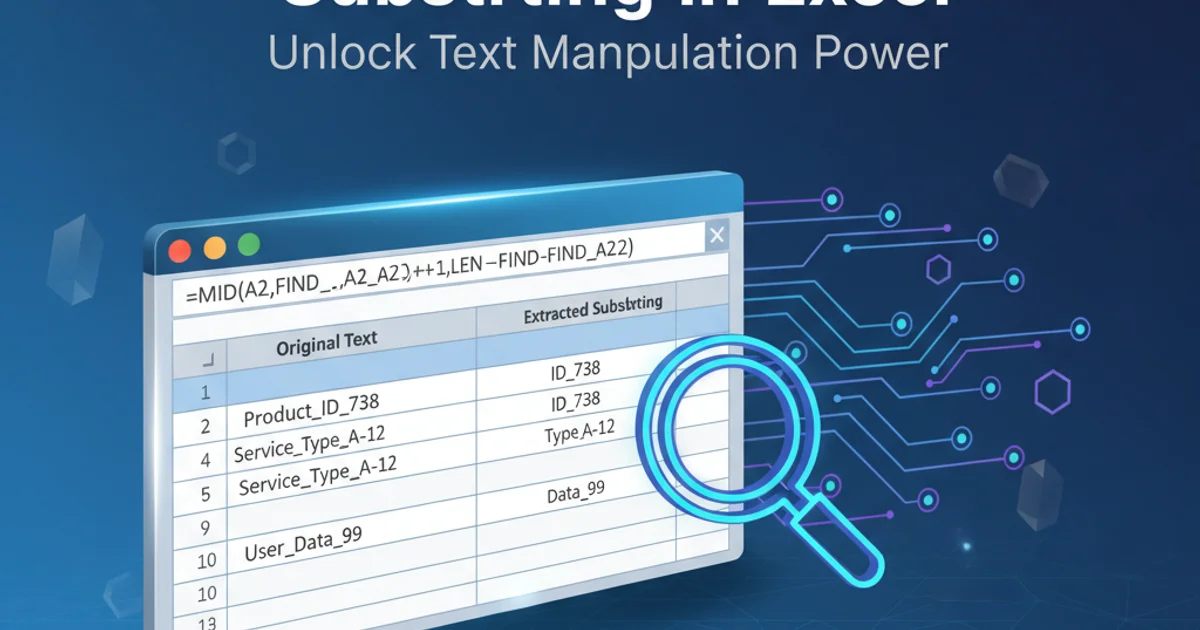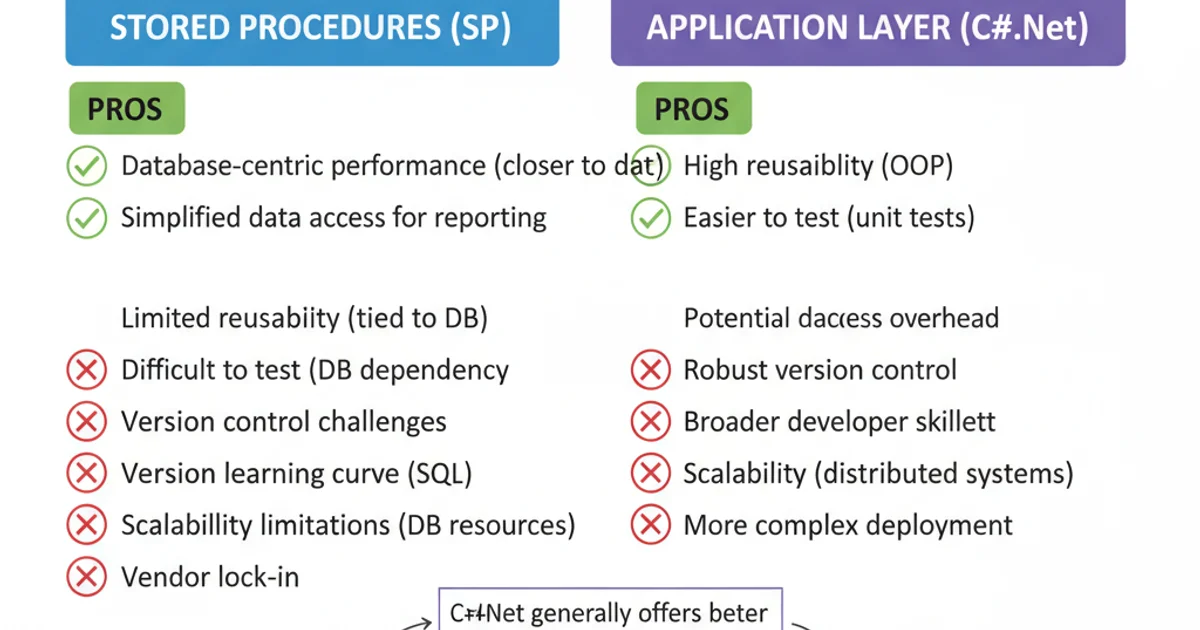Payroll System Design, Business Logic in SPs or Application Layer (C#.Net), Maintainability - Repost
Categories:
Payroll System Design: Stored Procedures vs. Application Layer for Business Logic

Explore the architectural choices for implementing payroll business logic, comparing the use of stored procedures in the database versus C# .NET in the application layer, focusing on maintainability, scalability, and performance.
Designing a robust payroll system involves critical decisions about where to place complex business logic. This article delves into the perennial debate: should core payroll calculations and rules reside within database stored procedures (SPs) or be implemented in the application layer, specifically using C# .NET? We'll examine the implications of each approach on maintainability, scalability, performance, and overall system architecture, providing insights to help you make an informed decision for your next payroll system.
The Case for Stored Procedures
Stored procedures offer several advantages, particularly in scenarios where data integrity and performance are paramount. By encapsulating business logic directly within the database, SPs can ensure that rules are consistently applied regardless of the application accessing the data. They can also reduce network round trips, as complex operations are executed on the database server, potentially leading to performance gains for data-intensive tasks.
flowchart TD
A[Application Layer] --> B{Call Stored Procedure}
B --> C[Database Layer]
C --> D{Execute Business Logic in SP}
D --> E[Access/Manipulate Data]
E --> C
C --> B
B --> F[Return Results to Application]Flowchart of business logic execution using stored procedures.
CREATE PROCEDURE CalculateEmployeePay
@EmployeeID INT,
@HoursWorked DECIMAL(5,2),
@HourlyRate DECIMAL(10,2)
AS
BEGIN
DECLARE @GrossPay DECIMAL(10,2);
DECLARE @TaxRate DECIMAL(5,4) = 0.20; -- Example tax rate
DECLARE @NetPay DECIMAL(10,2);
SET @GrossPay = @HoursWorked * @HourlyRate;
SET @NetPay = @GrossPay * (1 - @TaxRate);
-- Insert or update payroll record
INSERT INTO PayrollRecords (EmployeeID, GrossPay, NetPay, PayDate)
VALUES (@EmployeeID, @GrossPay, @NetPay, GETDATE());
SELECT @GrossPay AS GrossPay, @NetPay AS NetPay;
END;
Example of a simplified payroll calculation stored procedure.
The Case for Application Layer Logic (C# .NET)
Implementing business logic in the application layer, typically using a language like C# .NET, aligns well with modern software development practices, including Object-Oriented Programming (OOP) and N-Tier architecture. This approach promotes better separation of concerns, making the code more modular, testable, and maintainable. It also allows developers to leverage a rich ecosystem of tools, frameworks, and libraries available in the application language.
classDiagram
class PayrollService {
+CalculateGrossPay(hours, rate)
+CalculateNetPay(grossPay, taxRate)
+ProcessPayroll(employeeId, hours, rate)
}
class EmployeeRepository {
+GetEmployee(id)
+SavePayrollRecord(record)
}
class PayrollRecord {
+EmployeeID
+GrossPay
+NetPay
+PayDate
}
PayrollService "1" --> "1" EmployeeRepository : uses
PayrollService "1" --> "*" PayrollRecord : createsClass diagram illustrating application layer components for payroll processing.
public class PayrollService
{
private readonly IEmployeeRepository _employeeRepository;
public PayrollService(IEmployeeRepository employeeRepository)
{
_employeeRepository = employeeRepository;
}
public PayrollResult ProcessPayroll(int employeeId, decimal hoursWorked, decimal hourlyRate)
{
// Business rule: Validate hours worked
if (hoursWorked < 0) throw new ArgumentException("Hours worked cannot be negative.");
decimal grossPay = CalculateGrossPay(hoursWorked, hourlyRate);
decimal taxRate = GetTaxRate(employeeId); // Could fetch from a tax service or database
decimal netPay = CalculateNetPay(grossPay, taxRate);
var payrollRecord = new PayrollRecord
{
EmployeeID = employeeId,
GrossPay = grossPay,
NetPay = netPay,
PayDate = DateTime.Now
};
_employeeRepository.SavePayrollRecord(payrollRecord);
return new PayrollResult { GrossPay = grossPay, NetPay = netPay };
}
private decimal CalculateGrossPay(decimal hoursWorked, decimal hourlyRate)
{
return hoursWorked * hourlyRate;
}
private decimal CalculateNetPay(decimal grossPay, decimal taxRate)
{
return grossPay * (1 - taxRate);
}
private decimal GetTaxRate(int employeeId)
{
// Placeholder for fetching actual tax rate
return 0.20m; // Example tax rate
}
}
public class PayrollResult
{
public decimal GrossPay { get; set; }
public decimal NetPay { get; set; }
}
C# example of payroll calculation logic within an application service.
Maintainability, Scalability, and Performance Considerations
The choice between SPs and application layer logic significantly impacts the long-term viability of your payroll system.
Maintainability: Application layer code, especially in C# with strong typing and OOP principles, is generally easier to read, debug, and refactor. Tools for version control, unit testing, and continuous integration are more mature for application code. SPs can become 'black boxes' if not well-documented and can be harder to manage in large teams.
Scalability: Application layer logic scales horizontally more easily by adding more application servers. Database scaling, especially for write-heavy operations, is often more complex and expensive. However, SPs can offload some processing from the application servers, which might be beneficial in certain high-transaction scenarios.
Performance: For simple CRUD operations or complex data transformations that can be done entirely within the database, SPs can offer a performance edge due to reduced network latency and optimized execution plans. For complex business rules involving external services, multiple data sources, or extensive conditional logic, the application layer often provides better performance and flexibility.

Comparative analysis of Stored Procedures vs. Application Layer for business logic.
Hybrid Approaches and Best Practices
Often, the best solution is a hybrid approach. Simple data validation and integrity checks can remain in the database (e.g., using constraints, triggers, or basic SPs), while complex, evolving business rules, integrations with external systems, and reporting logic are handled in the application layer. This leverages the strengths of both environments.
Best Practices:
- Clear Separation: Define clear boundaries between data access, business logic, and presentation layers.
- Testability: Design for testability from the outset. Application layer logic is inherently easier to unit test.
- Version Control: Ensure all code, including database scripts and SPs, is under robust version control.
- Documentation: Document all business rules, regardless of where they are implemented.
- Performance Profiling: Profile your system to identify bottlenecks and make data-driven decisions about where to optimize.